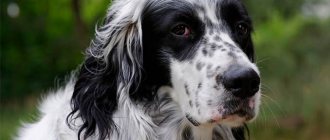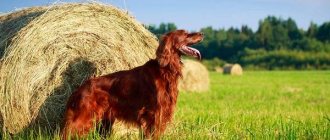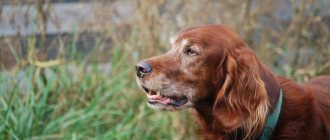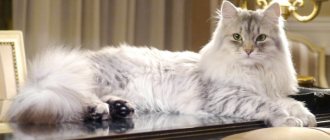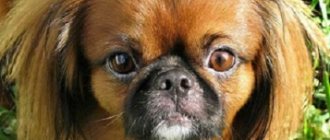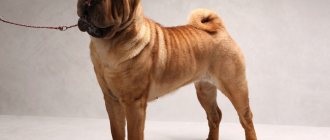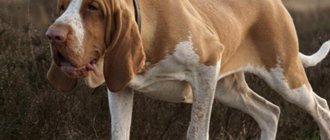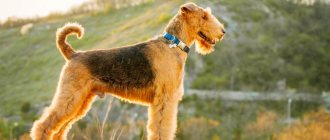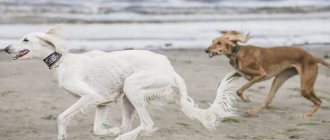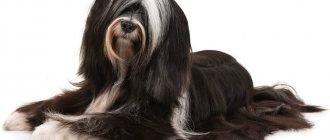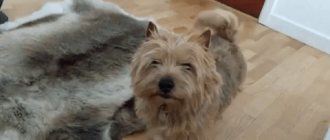The Gordon Setter or Scottish Setter is a large, harmoniously built dog with thin, low-set ears and an intelligent look of bright dark brown eyes. It originates from extinct varieties of spaniels and is intended for gun hunting of swamp and steppe game. Let's find out what a Gordon Setter is and what the specifics of keeping the breed are.
History of the Scottish Setter breed
Scottish Setter
The breed was fully formed by the second half of the 19th century, and residents of Scotland and Foggy Albion tried to hunt with its representatives back in the 18th century. As for the pedigree of the animals, British breeders have never hidden the fact that the Scottish Setter is a more “pumped up” copy of the disappeared Land Spaniel, famous for its outstanding ability to detect hidden game.
Unlike their extinct ancestors, setters are easier to climb and develop greater search speed, but their work is guided by the same principles. Since 1924, the name “Gordon” was first used in relation to the breed. This was done in order to perpetuate the name of Alexander Gordon, the Scottish Duke who owned the largest setter nursery in the country and was the first to develop a breed standard for them. It is known, for example, that most Gordon dogs had a three-color color, rather than a two-color color, as in modern individuals.
Black and Tan Setters owe their heavy constitution to the Scottish Major Douglas. In the 40s of the 19th century, the breeder decided to improve the exterior characteristics of the breed by infusing bloodhound blood. Gradually the plan got out of control, and each new litter of puppies began to be distinguished by a pronounced dampness of build. As a result, we had to take a step back and cross Gordons with Irish Setters in order to lighten the texture of the former.
In 1842, Gordon Setters reached the United States: two puppies named Rake and Rachel were bought from one of the European nurseries and sent to conquer the New World. The breed arrived in Russia at about the same time, but never entered into pure breeding. And only after the exhibition in Newcastle in 1859, when the fashion for Scottish setters swept almost the entire continent, breeding pairs of dogs began to be imported into the country. For a long time, the place with the most purebred Gordons in pre-revolutionary Russia was the Caucasus, where in the kennels of the imperial governor, Grand Duke Mikhail Nikolaevich, the breed was bred according to all breeding rules.
Hunting qualities
Dogs of this breed enthusiastically hunt in any area:
- In the woods;
- on the fields;
- in water places;
- in the swamps.
The dog is tireless in the literal sense of the word, he will bleed his paws, but will pursue his victim. However, such single-mindedness can bring a number of problems. So Gordon can seriously injure his paws on the reeds, injure them, stretch his muscles, and get hypothermia. Therefore, daily training and loads are important, regardless of the time of year and weather conditions.
As soon as the puppy receives the vaccine, training can begin. First of all, these are the basic commands. After this, the dog is taught not to be afraid of shooting from a gun, to float on the water and maintain restraint in unforeseen situations. Once the calling commands and other basic exercises have been mastered, the Gordon is taught to track and grab a bird. Most often, quails that are released from the cage are used for these purposes. At the same time, the dog should not show obvious aggression and try to kill the game.
Scottish Setter breed standard
Gordon has a more impressive constitution than the English and Irish Setters, although he does not have a pronounced damp build. Purebred dogs, especially males, look like muscular athletes, and their running during the hunt, accompanied by a deceptively heavy gallop, has long been a feature of the entire breed.
Head
Scottish Setter puppy
The overall massiveness of the skull with a voluminous parietal zone is compensated by the dryness of the outlines. The rounded forehead is divided into two parts by a longitudinal groove. The occipital protuberance (falcon) is well developed, as are the brow ridges. The relief of the foot is high. The muzzles of Gordons are wide, dry and practically do not narrow towards the nose.
Eyes
The eyelid incision is rounded. The eyes themselves are quite large and set straight.
Nose
A large shiny lobe can only be black. Brown color is not acceptable for the Scottish Setter.
Lips, teeth, jaws
The upper lip does not hang down, but fits tightly along the entire jaw line. The lower corner of the lip has a slight cut, which is especially noticeable in Scottish Setter dogs. Moderately drooping corners of the mouth are also considered an acceptable feature. A scissor bite is formed by the meeting of large white teeth.
Ears
Gordons have very soft, wide, drooping ears that are set just above eye level. The tip is softly rounded, the ear flap itself fits well to the zygomatic area of the head. The outer side of the hearing organs is “dressed” in long wavy hair.
Neck
The breed is characterized by a long, dry outline and, at the same time, a very powerful neck. The angle of inclination relative to the back is no more than 45-50°.
Me and my crazy friend
Frame
The well-developed, convex withers protrude noticeably above the dog's muscular back. The lumbar region is short but voluminous, the croup is slightly sloping, long and wide at the same time. Moderately deep chest with a steep rib curve smoothly transitions into a tucked belly.
Limbs
The Scottish Setter's legs are massive and dry, parallel to each other when viewed from the back and front. The forearms are strong, the pasterns are short, slightly inclined, the glenohumeral angles are within 100°. With rather long thighs and shins, Gordon's metatarsals are rather short, vertically set. The paws are large, rounded, with a hard “brush” of fur between the tightly clenched toes.
Tail
Very mobile, straight or with a saber-shaped bend. Typically, black and tan setters wear their tails no higher than their backs.
Color
Snatched a medal
Today's Gordons are blue-black with well-defined tan spots located:
- under the lower jaw and cheekbones;
- on the eyebrows;
- on the back of the ears;
- in the lip area;
- on the chest (marks in the form of triangles);
- on the inside of the forearms - from the wrists to the tips of the paws;
- on the inside of the thighs, metatarsals (front), paws.
The tan under the tail forms a distinct spot. Allowed: small white markings under the neck, a small amount of black or white hair on the fingers - a heritage of the Duke of Gordon Setters.
Wool
Scottish Setters have a soft, slightly wavy coat of sufficient length. The head and front of the legs are covered with short, recumbent hair. Feathering is present on the ears, the back of all four limbs, the lower abdomen and chest. The tail is decorated with a lush dewlap, which gradually shortens towards the tip.
Possible defects
Defects, the presence of which will not only affect the Scottish Setter’s show score, but may also lead to exclusion from the ring:
- height at the withers is higher or lower than the approved standard by more than 2 cm;
- too dry or rough constitution;
- missing tan spots and brown color instead of black;
- sharp muzzle;
- depigmented nose;
- ears below the eye line, curled into a tube;
- slanted eyelids, eyes of any color except brown;
- absence of incisors and direct bite;
- pendant around the neck;
- back with a “saddle” or humpback, shallow sternum;
- eversion of the elbows and hock joints, as well as their proximity;
- loose, clubfooted or splayed paws;
- the tail is on one side, tucked over the back or in a hook.
The same deficiency, depending on its severity, can be assessed by the commission as a slight or gross non-compliance with the standard. In the first case, the dog simply will not receive the champion title, in the second, it will withdraw from the exhibition and breeding distance.
What to feed correctly
Gordon's diet includes additional additives that improve growth and coat quality! Don't buy chemicals right away. Nettle or kelp added to natural food (which is best fed to the dog) will perfectly replace artificial drugs, having a positive effect on the structure of the coat.
Setters eat in moderation. Make sure the food is balanced. A properly calculated and planned diet will reduce the risk of disease and avoid the manifestation of genetically determined diseases.
The breed is not predisposed to obesity. Proper nutrition is the main component affecting the health of your pet. The choice of diet is up to the owner: balanced dry food or nutrition with natural products.
Today, the number of supporters of feeding natural products is equal to the number of supporters of feeding dogs dry food. There is no clear answer. Generations of dogs grew up on dry food, enjoying excellent health and avoiding diseases.
Pros of nutrition based on dry food:
- The food is completely balanced. Includes essential vitamins, minerals and supplements.
- Feeding dry food saves time; you don't have to prepare food to feed your dog.
- All feeds take into account the daily requirement of vitamins and minerals. They are divided into foods intended for various breeds.
- The daily food intake is indicated depending on the height, weight and lifestyle of the pet.
You will need to know what to feed Gordon Setter puppies. Before changing the diet of a small dog, ask the breeder how and what the owner fed the younger generation. Then carefully, gradually, constantly looking closely at the reactions of the puppy’s body, transfer the baby to the chosen type of food. Follow the basic rules to help your pet avoid difficulties associated with improper digestion.
- After the puppy reaches one month of age, new foods are introduced into the diet, for example, cottage cheese.
- During the period of active growth, the growing dog is provided with high-calorie and calcium-containing food.
- Make sure that your young dog receives the required daily intake of vitamins and minerals during the growth period.
- Do not offer treats: chocolate, gingerbread, candy. Products cause allergies.
Photo of Scottish Setter
Character of the Scottish Setter
On the same wavelength,
Gordon is not only the largest representative of the setter clan, but also the most balanced. It is very difficult to get an animal angry: Gordons do not even consider meetings with strangers to be a sufficient reason to turn on a biting dog. Of course, there will be some degree of wariness in behavior, but a well-mannered and timely socialized Scottish Setter will definitely not show open aggression. However, if the owner makes it clear that he wouldn’t mind hearing Gordon’s warning “Woof!” in relation to a stranger, he will receive it.
Despite their outward equanimity, it would be a big mistake to consider Scottish setters to be natural goodies. The descendants of Land Spaniels are quite stubborn and, if they do not develop a system of prohibitions, they quickly turn into delivery dogs. It’s not difficult to list what awaits the owner of an ill-mannered pet: fights between the animal and its fellow tribesmen, constant pestering of a person out of boredom, making “author’s” changes to the interior of the home, such as scratches on the wallpaper and holes in the curtains.
"I am listening really carefully".
However, experienced dog handlers claim that the Scottish Setter is one of those unique breeds whose representatives are extremely difficult to fit to standards. Among them there are equally phlegmatic individuals and restless hooligans. An important feature: black and tan setters love to gain experience on their own, no matter whether it’s positive or negative. This is easy to notice: in the presence of the owner, the dog is obedient and reacts correctly to prohibitions, but, left alone, he strives to try what the person does not allow. Gordon will learn to avoid danger only after he gets into trouble on his own and understands that curiosity does not always lead to a positive result.
The Scottish Setter is a sociable and active dog that absolutely cannot stand long periods of loneliness. All these qualities are not corrected in any way, so either you put up with the peculiarities of your ward’s temperament, properly loading him with work and communicating, or you abandon plans to have a representative of this breed. You should not buy a Scottish Setter as a city dog. Gordons are hunters and freedom-loving creatures, so the role of a decorative pet is not the ultimate dream for them, but something akin to punishment.
Main characteristics
| Breed parameters | |
| Country of origin: | Great Britain |
| Weight of the breed: | males: 25-36 kg, females: 20-32 kg |
| Height at withers: | males: 61-69 cm, females: 58-66 cm |
| Temperament: | active |
| Wool: | average |
| Role in human life: | companion, hunting |
Despite the large number of advantages, the breed has not become fashionable. This happened due to the Scottish Setter’s great mobility and unsuitability for small spaces. The dog will not be able to get along in an apartment unless it has a significant square footage. It is much more familiar and easier for a hunter to scour the area of a private house. Temperament will not allow the setter to become a simple pet.
Hunting with Gordon
Gordons are considered the best assistants for novice hunters. With highly developed search instincts, “Scots” are much more balanced than their relatives in the section, and therefore easier to manage. When hunting, the breed does not go far from humans, is ready to work in any weather and is practically tireless, which is valuable when working with swamp, forest and steppe game. The black and tan setter works with its upper senses, making a distinct, if not picturesque, stance when detecting prey. Some individuals are capable of aerobatics - freezing in a stance, periodically looking back at the hunter, inviting him with a look to join the process.
Education, training, coaching
Cunning, stubbornness, and lack of guilt are character traits that Gordon will demonstrate in his first obedience lessons. Almost all Scottish setters are fluent in the art of pretense and know how to make soulful, guilty faces when they are reprimanded, but in their hearts they remain unconvinced. The intensity of resistance to learning largely depends on the techniques used by the owner. It is quite possible to train a setter, the main thing is not to demand from him the diligence of a service worker and to be able to use rewards in a timely manner, be it a treat or affection.
One team
Opinions of professional hunters on issues of training the breed are divided. Some specialists prefer to develop a dog’s diligence using electric collars. The method is based on the fear of pain and is considered effective, but if you are concerned about the mental health of your pet, it is better to avoid such devices. Spanking with a whip is also not the best way to wean a Scottish Setter from bad habits. By the way, the breed is very poorly retrained, so it is better to correct behavioral errors without delay.
You need to start socializing your puppy at 12 weeks of age. During this period, Gordon must learn such commands as “Come to me!”, “Place!”, “Walk!”, and the baby must know his nickname and respond to it. Three-month-old puppies still have fresh memories of their mother's care, so pet and caress your little setter often.
It is also necessary to point out to the animal the inadmissibility of destructive behavior “in a maternal way,” that is, as is customary in the animal community. If the puppy begins to bite the fingers of family members or grumble in response to commands, rein him in by picking him up by the collar and then lightly shaking him or pressing him to the floor by the neck. And of course, it is important not to take away the child’s childhood, so the dog’s daily routine should leave room for harmless pranks like picking up socks, chewing on toys and other emotional attacks.
At 6 months old, a Gordon puppy can be gradually introduced to training. True, by this moment he is obliged to carry out basic commands upon request. When going out into the field, try to keep the dog as close to you as possible. If Gordon is distracted by birds and runs away, he must be returned to the leg with a shout or taken on a leash. If your pet is overexcited, let him go, let him chase the living creatures, and at this moment hide. Having played enough, the setter will begin to worry and look for you - “sweat” the lawless guy a little until he whines, and leave his shelter. The fear of loss will wean the puppy from spontaneous chasing and discipline it for further hunting.
In the field, the commands “Sit!” must be practiced until they become automatic. and “Lie down!”, searching with a shuttle, stretching, as well as standing and correct presentation of game from land and water. Effective methods for mastering these skills are easy to find on breed forums. You can also learn techniques from experienced hunters who work with any cops. The habit of the sound of a shot will also have to be formed gradually. The best option, recommended by experts, is a shot from under the counter, when the dog is focused on the prey and reacts less sharply to external stimuli.
Maintenance and care
The Scottish Setter is not an apartment or kennel dog, so if you want maximum comfort for your pet, place it in a country house where your ward will have free access to walks in the yard. Taking Gordon outside is necessary not only so that he has the opportunity to warm up, but also for mental balance. A dog that is constantly cooped up even in the largest yard becomes suspicious of strangers and makes a fuss over trivial matters.
Hygiene and grooming
No... I won’t go for a walk today
The soft, long coat of Gordon Setters is the best “net” for all kinds of debris. When hunting, the animal is hung with blades of grass, thorns, and dry plant seeds, so include in your budget in advance the cost of combs (frequent, rare), as well as rubber mittens and brushes. Every three days, check your Scottish Setter's coat for mats, which usually form around the elbows and behind the ears. It is better to disassemble the dog in these places with the help of conditioning lotions for combing - it is both more pleasant for the dog and saves time. It is advisable to comb the body with a rubber mitten once every couple of days to remove dead hairs. During the molting period, it is recommended to carry out the procedure daily.
Thinning of the fringe on the ears and limbs is allowed, but do not overdo it - remove only the hair that bothers the pet and looks untidy. For working dogs that do not need to attend exhibitions, before the hunting season, the hair on the neck and behind the ears is clipped - these are the areas where all the field debris clings. The length of the fur remaining after cutting should be at least 1 cm, since shorter hair will not be able to protect the pet from insect bites, which are always abundant in swamps and fields. The wool between the toes and the anal area are also trimmed to make it easier to monitor the dog’s hygiene.
Breeders recommend bathing Scottish setters when they become dirty, and in the winter months they suggest eliminating this procedure altogether, replacing it with thorough combing and dry brushing. Gordon should be washed with professional dog cosmetics. If this is not available, a regular shampoo for dry hair that does not contain aggressive surfactants will do. Specimens working for swamp game willingly take a bath in natural bodies of water if the temperature allows. So in the summer you can go to any beach with your dog and have a nice refreshment together. An obligatory nuance after such bathing is not to forget to rinse the wool with clean water in order to wash away the microscopic living creatures that live in ponds and rivers.
What are you watching? Cheshi belly
Trim Gordon's claws regularly - they grow very quickly in representatives of the breed and do not wear down even in the most active individuals. Ear cleaning is carried out at intervals of 1-2 weeks. It is better to remove excess sulfur not with a cotton swab, but with a cloth moistened with a hygienic composition and wrapped around your finger. Cleaning with lotions instilled into the ear funnel is also acceptable. The breed has trouble-free eyes, so just make sure that no debris gets into them while hunting, and remove dust bunnies with a cloth moistened with a decoction of chamomile or calendula.
Ideally, setters need to brush their teeth, but not all owners do this. If your dog is not used to having a brush in his mouth, introduce him to hard treats from an early age. Let the puppy chew carrots and vein bones. You can also add special compounds to drinking water to dissolve tartar, however, the costs in this case will be much higher than if you bought a brush and zoo paste. Remedies for ectoparasites will also have to be included in your mandatory purchases. This is especially true for representatives of working lines, who catch ticks during every hunting trip. The type of flea and tick treatment is up to the owner, with the exception of tablet medications, which must be approved by a veterinarian.
Feeding
Fans of the breed still cannot agree on what type of food is optimal for Scottish Setters - industrial “drying” or natural products. Each breeder decides the issue of feeding based on his own experience. It is necessary to use dry food not only taking into account its class and the amount of meat component, but also the age of the animal. A puppy weaned from a bitch up to 5 months old should eat only natural food, namely: milk, cottage cheese, lean boiled meat, fish fillet, boiled vegetables. Meat broths with a small amount of cereal are also allowed. At the age of 5 to 9 months, Gordons are allowed to introduce junior varieties of “drying” into the diet. The transition to “adult” food is carried out only at the 10th month of life.
There is no need to be sophisticated and come up with a special menu for an adult Scottish Setter. The simpler the dog's diet, the better for its health. In fact, adult Gordons can do everything the same as six-month-old puppies, with the exception of milk. It is no longer recommended to boil meat, and it is better to give fruits and vegetables raw, finely chopped and flavored with low-fat yogurt. Cereals—buckwheat and oatmeal—can be cooked in broth and mixed with meat scalded with boiling water to help reduce the cost of a portion of food. Useful supplements in the Scottish Setter's diet: dried kelp, corn or sunflower oil (unrefined, a tablespoon every few days), quail egg or chicken egg yolk.
Health and Diseases of Scottish Setters
Epilepsy, hip dysplasia, and hypothyroidism can be inherited from Gordon's ancestors. Scottish Setters are also susceptible to eye diseases, which include:
- cataract;
- entropion of the eyelids (in puppies under 1 year of age);
- Keratoconjunctivitis Sikka (lack of tear fluid).
You should be especially careful with dogs that are vomiting. This behavior may be a sign that the animal has developed gastric volvulus, which can be fatal. Another genetic pathology characteristic of Scottish setters is juvenile cellulite. The disease manifests itself in swelling of the cervical and submandibular lymph nodes, causing the muzzle to become very swollen.
Mating
Dogs are knitted when they are fully formed. Although puberty begins early (at 10-12 months), it is recommended to breed only at 2-3 years. The female will be physically and mentally ready to bear and give birth to puppies. During the third or quadruple heat (the most favorable period), symptoms of readiness will appear: a loose loop, light discharge, a playful mood.
Mating through the nursery is carried out for breeding individuals. The owners set a mating date, fill out forms and receive a certificate. The cost of mating depends on the wishes of the owner of the dog. Usually it is equal to 1 puppy.
On the appointed day, the girl is brought to the territory of the male dog. It is best to walk your pets together so they can socialize. Then the boy will mount if the female allows him. For the first time, it is better to invite a specialist who will help the owners understand the process.
After several active movements, the animals will freeze and stand in a castle. This state will last 15-20 minutes . It is important not to let the bitch sit down, but to hold the dog by the croup. If there was no lock, then the girl may be pregnant. Mating is repeated after 2 days . The course of pregnancy is monitored at a veterinary clinic.
Read a detailed article on the topic: “Everything you need to know about breeding dogs: appropriate age, what to do if it doesn’t work out, rules and tips.”
How to choose a puppy
Mom with puppy
- Decide why exactly you are getting a dog. If for hunting, there is no point in spending money on high-breed puppies from show producers. In such lines, the reference exterior is always a priority, and the working inclinations are relegated to the background.
- Carefully study the manufacturers' working documents. If a female or male Scottish Setter can only boast third-degree diplomas, they will be so-so hunters, and the offspring will most likely pass on the abilities of their parents.
- Gordon puppies from unscheduled matings are cheaper, but you won’t be able to shine with them at the show due to the lack of documents. Such animals are also not allowed for breeding, which does not prevent them from achieving good results in their work.
- The living conditions of the puppies are an important aspect. Choose nurseries that practice country growing. If dogs are kept in cramped conditions and locked cages, there is a chance to buy a weakened and sick baby.
- It is better to go to the breeder for the first examination when the puppy is 2-3 weeks old. At this point, it is already possible to make predictions about the future appearance of animals.
- It’s good if the seller can provide evidence that the producers do not suffer from genetic diseases in general and joint dysplasia in particular.
Nutrition
Before you take the puppy into your home, be sure to ask the breeder what to feed the pet, be sure to listen to all his recommendations and use them. When the puppy gets stronger, you will need to decide what exactly to feed your child: either natural products or special ready-made food. Of course, many people often choose the second option, because then they don’t have to spend a lot of time preparing food. In addition, dry food contains all the substances a dog’s body needs, and you don’t have to think about balancing the diet. However, the food must be of high quality. You need to purchase it in specialized stores, the food must be in sealed packaging, the food must contain meat, not soy and by-products.
It is very important for the Scottish Setter to receive all the necessary vitamins. A lack of nutrients immediately affects the condition of the setter's coat. If you decide to feed your pet natural food, do not forget about special vitamin supplements, which are usually recommended to be given throughout the month. In order for a dog to have a beautiful and shiny coat, it needs vitamins E and B12; vitamin C strengthens the immune system; Vitamin D prevents the development of rickets. Remember that you should also not overfeed your animal with vitamins, otherwise the consequences can be quite severe. Do not feed your dog legumes, potatoes, citrus fruits, grapes, yeast baked goods, sweets, smoked and pickled foods, canned food and processed foods.
Scottish Setter price
For more than 150 years, interest in Scottish setters in Russia has either increased or declined to a minimum. Today, the breed is again far from what is commonly called popular, so buying a puppy most likely will not be a quick thing. The cost of a Scottish Setter is primarily influenced by the purity of the pedigree, as well as the show and working diplomas of the parents. Typically, prices for puppies from working producers start at 30,000 rubles. The cost of offspring from show Gordons is 50,000 rubles and more.
